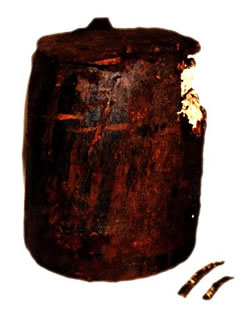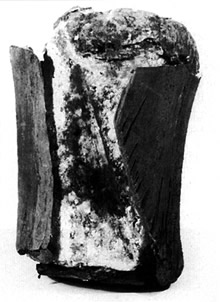| ||||||||||||||||||||||||||||||||||||


Buried butter
|
|
Butter sunk underMore than a hundred years Was recovered salty and white. The ground itself is kind, black butter Melting and opening underfoot, Missing its last definition By millions of years. Seamus Heaney |
Who needs a fridge for butter when there's a bog nearby?
The high acid content of the soil gives bogs great preservative qualities. It turns out that between the 6th and 19th centuries A.D., people in Ireland and Scotland buried their butter in bogs, making butter one of the most widespread archaeological items found in bogs.
 Why?
Since refrigerators did not exist in those days people had to rely on the peat
to protect the butter from daytime heat stop it from growing mould. To help
preserve the butter in earlier times, 5% or more salt was added to it. Then,
before the butter could be eaten, slices of it were first soaked in water to
reduce the salt content. If salt was scarce or unaffordable, the cold, anaerobic,
antiseptic peat offered an alternative way to preserve butter through the autumn
and winter. It also provided a way to preserve garlic butter, a special kind
of butter made especially for use during Lent. Salt could not be used to preserve
garlic butter because soaking in water before use would remove the garlic as
well as the salt. Unfortunately, there are very few accounts of “bog buttering”,
which might give an accurate picture of how it was actually buried in a way
that would ensure preservation.
Why?
Since refrigerators did not exist in those days people had to rely on the peat
to protect the butter from daytime heat stop it from growing mould. To help
preserve the butter in earlier times, 5% or more salt was added to it. Then,
before the butter could be eaten, slices of it were first soaked in water to
reduce the salt content. If salt was scarce or unaffordable, the cold, anaerobic,
antiseptic peat offered an alternative way to preserve butter through the autumn
and winter. It also provided a way to preserve garlic butter, a special kind
of butter made especially for use during Lent. Salt could not be used to preserve
garlic butter because soaking in water before use would remove the garlic as
well as the salt. Unfortunately, there are very few accounts of “bog buttering”,
which might give an accurate picture of how it was actually buried in a way
that would ensure preservation.
This suggests one of the primary reasons for burying butter, was a to preserve special types of butter made for certain, most likely festive seasons. Storage over a period was necessary to allow the added flavouring to penetrate the fat and season the butter evenly. Burial in a bog would ensure protection from daytime heat and keep the butter as cool as possible, while the exclusion of air, and the antiseptic qualities of the turf would prevent mould growth.
The containers in which the butter was buried give clues on the date of the “burial”. These containers were made from a variety of materials, including wood, bark, cloth, wickerwork and animal skins. The wooden vessels are sometimes carved out of a solid piece of wood, with a detachable lid or handle. Sometimes the base is a separate piece, cleverly inserted. Some vessels are made of stays. Carefully decorated wooden containers have been found, indicating how highly prized they were.
An account on Irish food written by Dinely in 1681 contains the following description: “Butter, layed up in wicker baskets, mixed with a sort of garlic and buried for some time in a bog to make a provision of an high taste for Lent”.
Bog butter and the cultural landscape
Although the practice may have originated with a desire to produce a specially flavoured butter, butter was very likely also buried for other reasons. As making butter was connected to an air of superstition, it is conceivable that butter was buried for animals. It could also have been associated with the formerly widespread Booleying System, whereby cattle and sheep were driven to upland pastures for the summer months. May butter was also buried for reasons of security and defence, as a common tactic in war was destroying the enemy's foodstuffs, thereby causing famine. English forces in Tudor and Stuart times acquired this strategy. In such a situation, discovering bog butter could indicate a sudden attack or flight of the people who stored it.
Considering the fact that milk and its products were the main food source of the Gaelic Irish until the collapse of the Gaelic order around 1700, butter was quite likely buried in bogs until the end of the 17th century. In Scotland, butter was stored in bogs for much longer and the tradition may have survived longer in some parts of Ireland as well. However, it is generally accepted that storing butter in bogs in this way is a Gaelic adaptation of a farm practice that was widespread throughout northern Europe.
 It
Tastes Rancid - of Athlete's Foot
It
Tastes Rancid - of Athlete's Foot
Bog butter deteriorates in appearance and flavour with time as the fat in the butter is decomposed by microbial action, and turned to adipocere. It is usually a hard, yellowish-white substance, a bit like cream cheese in texture and flavour. William Frazer described it as 'tasting like old spermaceti'. Hygienic standards being somewhat different than today's, bog butter usually contains plenty of cows' hairs. Bog butter was offered for sale in Tralee as late as 1853; the taste was described as “an-ghoirt”, a taste said to appeal to the early Irish. Other types of fat - such as sheep tallow - may also have been buried in bogs from time to time; when this is left for a long time, the fat also alters to adipocere and acquires a cheesy flavour.
Is ancient bog butter good enough to eat? Recently, some children from Barnderg National School in Ireland tested a 300-year-old lump of bog butter that was found by turf cutters in May 1999 (photo above). The lump looked, smelled, and felt like butter, but the kids said it wasn't very tasty.
"We'll probably bring it to the school for awhile," said Barnderg's principal Sylvester Cassidy. "It will be a novelty, but eventually it will start to melt and smell and then have to be thrown out." Maybe they could pour it on some 300-year-old baked potatoes.
Who needs a fridge for butter when there's a bog nearby
Turf Cutters churn up a taste of the past, though it's well beyond its sell-by date
Article from The Examiner, 20 May 1999 by Declan Varley
A group of schoolchildren have volunteered to be the custodians of a five stone lump of butter, buried on a bog over 300 years ago.
The butter was discovered yesterday in the Poll na gCapaill bog near Barnaderg in Co. Galway by turf cutters Tom Burke and Vincent Roche. According to one historian, it was traditional for butter to be stored in the bogs because of the great preservative qualities of the high acid soil.
Now the find, the largest of it's kind in the West, is to be preserved by the local schoolchildren, for a few months until it starts to melt.
Yesterday, the school children, from Barnaderg national school, were brought along by principal Sylvester Cassidy for a look at the largest lump of butter they had ever seen and they jokingly brought along a sliced pan in the hope that some of it could still be used.
"The men who found it have given it to us and we are going to get it examined to determine its exact age," said Mr. Cassidy.
"It was in a wicker basket and an outer layer of bark was placed around it by the people who put it there. We will probably bring it to the school for a while. "It will be a novelty, but eventually it will start to melt and smell so it will have to be thrown out then," said Mr. Cassidy.
He said the butter was not edible but still retained its buttery smell and texture and was extremely cool and hard.
Literature:
Caroline Earwood, Bog Butter: a two thousand Year History
The journal of Irish History VIII, 1997;
John Feehan u. Grace O´Donovan, The Bogs of Ireland. An Introduction to the Natural, Cultural and Industrial Heritage of Irish Peatlands, Dublin 1996, 460-462;
W. Fraser, Bog Butter: its History with Observation. J. R. S. A. I. 1890/91, 583-588;
M. ó Sé, Old Irish Buttermaking. Cork Historical and Archeological Society Journal 54 (1949), 61-67.
|
|
|
|

